Welcome to the vibrant world of the Blue-Tailed Bee-Eater, where beauty meets functionality in the avian realm. With its striking mix of green, blue, chestnut, and yellow plumage, this captivating bird is a delight for birdwatchers worldwide.
Beyond its aesthetic appeal, the Blue-Tailed Bee-Eater showcases remarkable hunting skills, displaying impressive aerial acrobatics as it snatches prey, primarily bees, mid-flight.
Their unique ability to remove stings from bees before consumption sets them apart in the avian kingdom. As we embark on this journey, we’ll uncover the intricacies of their behavior, breeding habits, and migration routes, revealing the true uniqueness of these multicolored wonders.
Join me in exploring the mesmerizing world of the Blue-Tailed Bee-Eaters!
Physical Description of the Blue-Tailed Bee-Eater
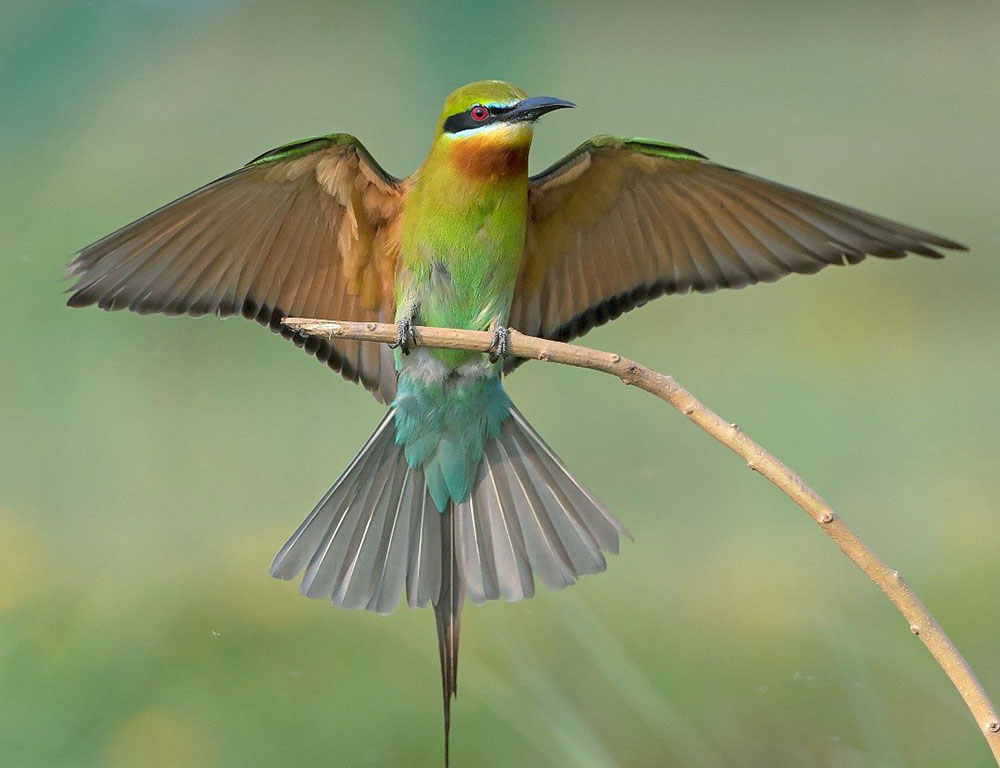
The Blue-tailed Bee-Eater is a visually striking bird characterized by its vibrant plumage and distinctive physical features.
Let’s delve deeper into its remarkable appearance:
Size
Blue-Tailed Bee-Eaters typically measure 9 to 11 inches in length, making them relatively small birds compared to other avian species.
Plumage
Their plumage showcases a dazzling array of colors. The upperparts are predominantly green, while the underparts display shades of blue and chestnut.
However, their elongated central tail feathers, a bright blue color with black tips, truly sets them apart, creating a striking contrast against the rest of their plumage.
Body Structure
Blue-tailed Bee-Eaters have a slim and streamlined body, aiding their agility during flight. Their wings are long and pointed, facilitating swift and precise aerial maneuvers.
Beak
The Blue-tailed Bee-Eater possesses a pointed and slightly curved beak perfectly adapted for capturing its preferred prey of bees and other insects. Despite its delicate appearance, the beak is a formidable tool for hunting.
Eyes
These birds have binocular vision, providing them with impressive depth perception. This visual adaptation is advantageous for hunting fast-moving insects mid-flight, allowing for accurate targeting and successful prey capture.
Sexual Dimorphism
While there is minimal sexual dimorphism in this species, one notable difference lies in the length of the tail feathers. Males tend to have slightly longer tail feathers than females, although this distinction may be subtle.
Habitat and Distribution of Blue-tailed Bee-Eaters
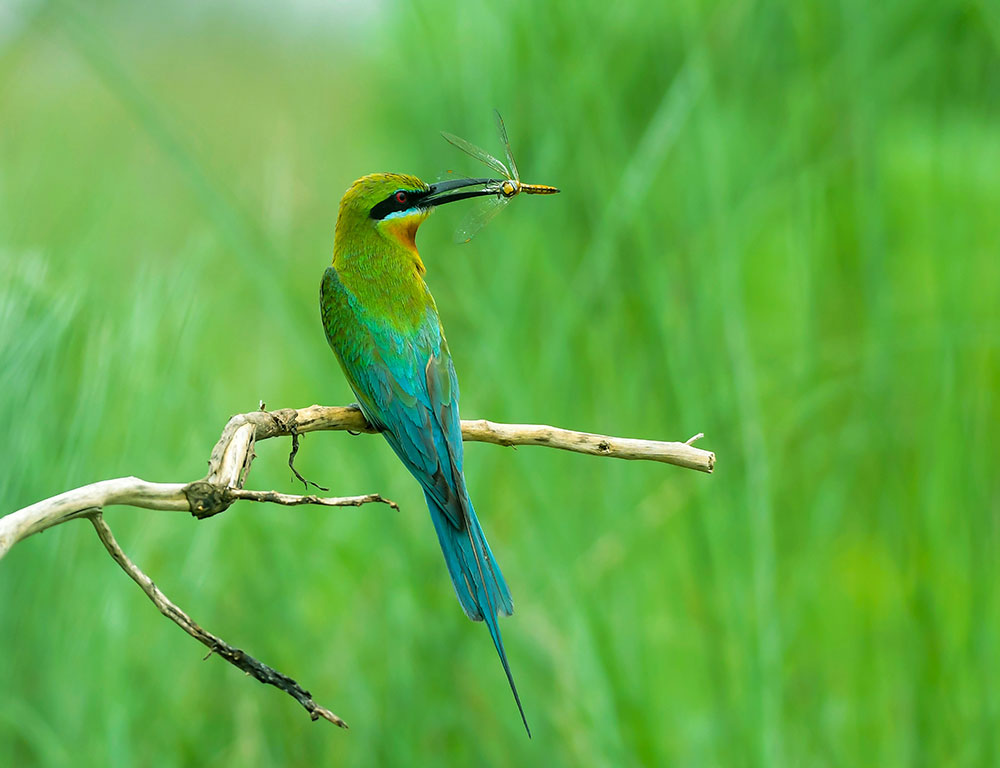
The Blue-tailed Bee-eater (Merops philippinus) presents a fascinating range of habitat preferences and distribution patterns, making it an intriguing subject for birdwatchers and researchers alike.
Preferred Habitats
These vibrant birds prefer habitats near water bodies, such as rivers, lakes, and wetlands. These areas provide an abundant supply of their primary food source: bees and other flying insects.
Additionally, they are often observed in open areas with short grasses or bare ground, where their prey tends to be plentiful.
Geographic Distribution
The Blue-tailed Bee-eater boasts a wide geographic distribution across Asia and the Pacific Islands. They are commonly sighted in India, China, Indonesia, and Papua New Guinea.
Their presence in these regions varies throughout the year, reflecting their migratory behavior.
Migratory Patterns
The migratory patterns of Blue-tailed Bee-eaters are intriguing and variable. In mainland Asia, they are summer residents from April to September, coinciding with the bee-breeding season. During this time, they inhabit territories in regions like India and China.
However, come winter, these birds migrate southwards. For example, some may travel to Sri Lanka during the colder months.
Behavior and Diet of the Blue-Tailed Bee-Eater
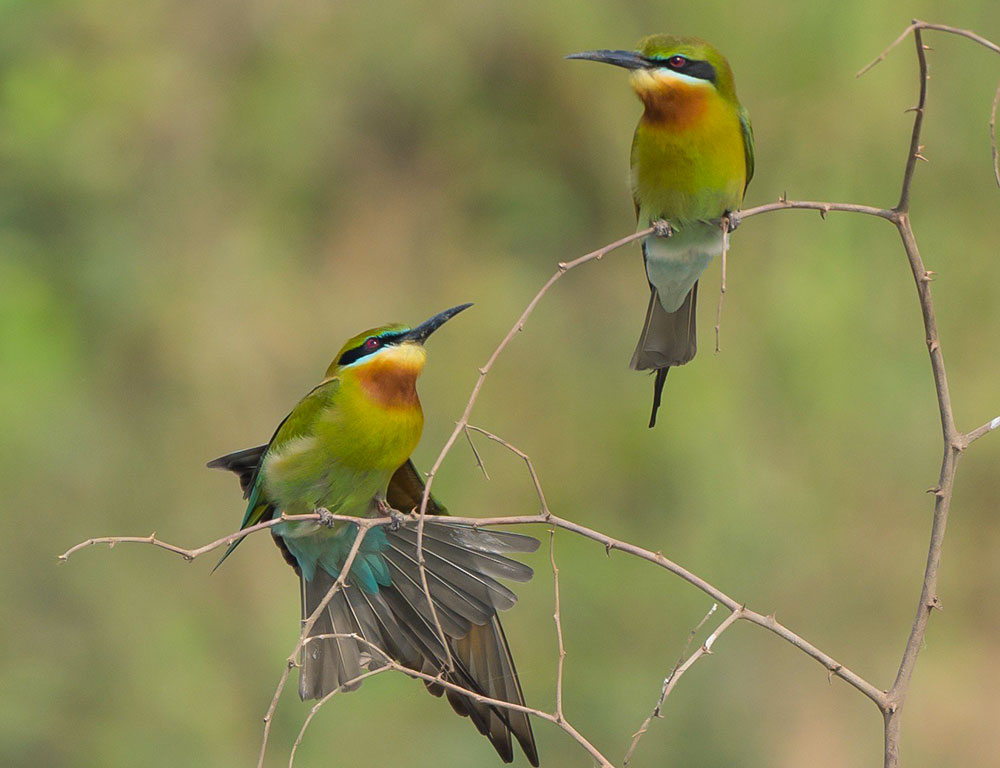
The Blue-tailed Bee-Eater is a captivating species with its vibrant plumage and fascinating behaviors.
Let’s delve deeper into their behavior and diet:
Acrobatic Flight Patterns
Blue-tailed Bee Eaters are renowned for their agile and acrobatic flight. They exhibit swift movements as they dart through the air, showcasing their prowess as skilled aerial hunters.
Hunting Techniques
These birds primarily feed on bees and dragonflies, displaying remarkable hunting skills by capturing their prey mid-flight. Their agile flight allows them to navigate swiftly and snatch insects out of the air with precision.
Unique Prey Handling
After capturing a bee, Blue-tailed Bee-Eaters have a distinctive habit of rubbing the prey against their perch. This behavior removes the bee’s sting before consumption, showcasing their ingenuity in handling potentially dangerous prey.
Diet Variation
Despite their name suggesting a preference for bees, Blue-tailed Bee-Eaters adapt their diet according to seasonal availability. When bees are scarce, they switch to consuming butterflies and other small insects, demonstrating their flexibility in foraging habits.
Family Dynamics
Both adult and juvenile Blue-tailed Bee-Eaters partake in hunting and feeding activities. Once young birds are old enough to fly and hunt independently, they join the family’s foraging endeavors, highlighting the importance of familial cooperation in their social structure.
Social Nature
Blue-tailed Bee-Eaters are social creatures that prefer the company of others. They are often observed roosting in large numbers at communal sites, such as tree branches or cliffsides. This social behavior enhances their sense of security and facilitates communication among group members.
Distinctive Calls
The Blue-tailed Bee-Eaters communicate through musical calls, including variations of ‘pre’ or ‘pro’. These vocalizations serve as a means of communication within the group and can be heard echoing through their habitat.
Nesting and Breeding Habits of Blue-tailed Bee-Eaters
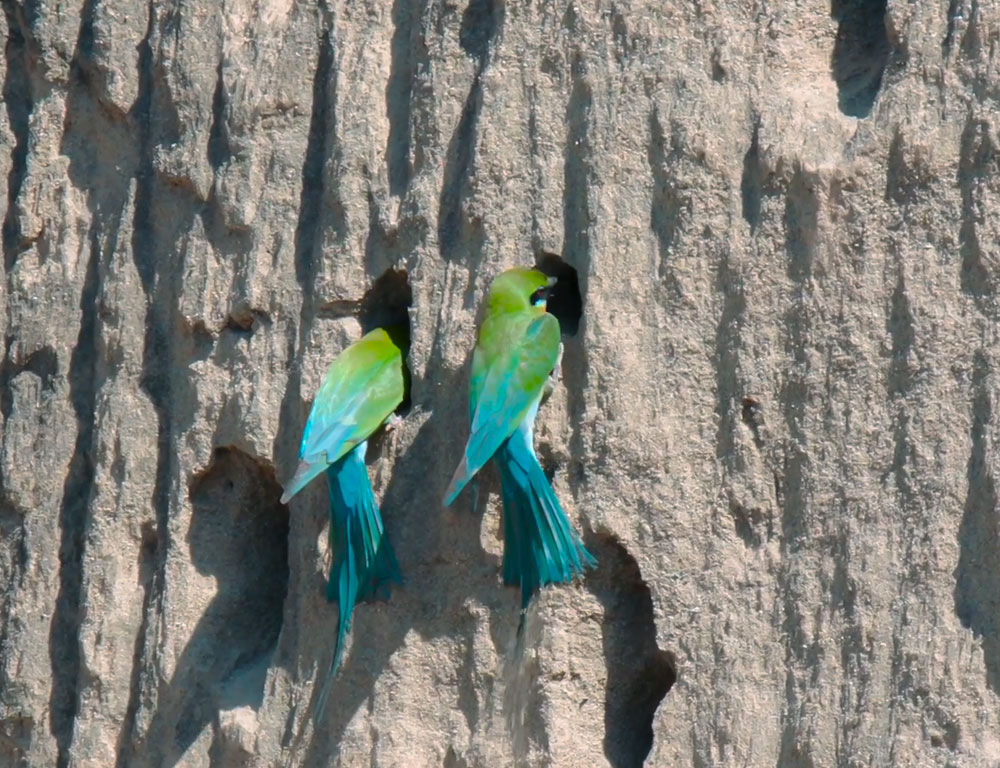
The nesting and breeding behaviors of the Blue-Tailed Bee-Eater add another layer of fascination to this already remarkable species.
Let’s delve into the intricacies of their nesting habits:
Colony Nesting
Blue-tailed Bee-Eaters exhibit colony nesting behavior, forming large communities ranging from several pairs to hundreds nesting together. These colonies are often found on sandy banks or cliffsides.
Nest Construction
Unlike some birds that utilize existing holes or crevices, Blue-Tailed Bee-Eaters are skilled excavators. They use their sharp bills to dig long tunnels into the sandy banks or cliffs, leading to a broader chamber where they build their nests and lay eggs.
Nesting Timeline
- Excavating Tunnel: It takes Blue-tailed Bee-Eaters approximately 5-14 days to excavate the tunnel leading to their nesting chamber.
- Laying Eggs: After tunnel completion, female Blue-tailed Bee-Eaters lay between five and seven glossy white eggs per clutch within 2-7 days.
- Incubation Period: The incubation period lasts around 15 days, during which the parents take turns to keep the eggs warm.
- Fledgling Age: After approximately 30 days, the chicks reach fledgling age and are ready to leave the nest.
Parental Roles
Female Blue-tailed Bee-Eaters primarily lay eggs, while both parents participate in incubating the eggs and caring for the chicks after hatching.
Breeding Season
The breeding season typically occurs between March and June, although specific timing may vary depending on geographical location. During this period, the birds engage in elaborate courtship displays characterized by vibrant colors and impressive aerial acrobatics.
Conservation Status of the Blue-Tailed Bee-Eater
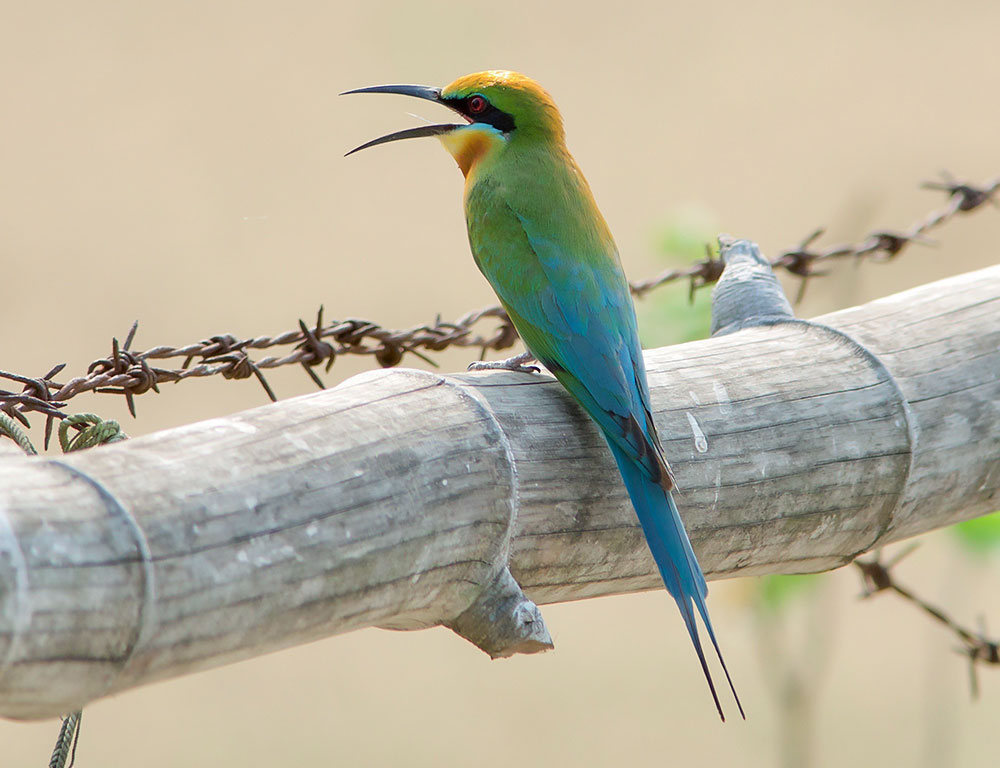
The conservation status of the Blue-Tailed Bee-Eater presents a complex situation despite being listed as ‘Least Concern’ by the International Union for Conservation of Nature (IUCN).
While they are not currently facing immediate threats of extinction, several challenges jeopardize their long-term survival:
Habitat Loss
One of the primary threats to Blue-tailed Bee-Eaters is habitat loss due to human activities such as urbanization and land development.
These birds prefer open habitats near water bodies like rivers or lakes, which are increasingly encroached upon by expanding human settlements. Hundreds of nesting sites are lost each year due to such development projects.
Climate Change
Changes in climate patterns pose another risk to Blue-Tailed Bee-Eaters. Unpredictable weather conditions can disrupt the availability of bees and insects, essential components of their diet.
Such disruptions in the food supply chain can significantly impact these birds’ survival and reproductive success.
Given these threats, proactive conservation efforts are essential to ensure the long-term survival of Blue-tailed Bee-Eaters:
Establishment of Protected Areas
Protected areas around known nesting sites and essential foraging habitats can help safeguard the Blue-Tailed Bee-Eaters from further habitat loss and human disturbance.
Education Initiatives
Public awareness campaigns and educational initiatives can raise awareness about the importance of conserving Blue-Tailed Bee-Eaters and their habitats.
By engaging local communities and stakeholders, efforts can be made to mitigate human-induced threats and promote coexistence with these birds.
Continued Research
Research efforts should continue to enhance our understanding of Blue-Tailed Bee-Eaters’ behavior, ecology, and specific habitat requirements. This knowledge can inform conservation strategies and management practices aimed at protecting and restoring their populations.
Conclusion
The Blue-tailed Bee-Eater is a testament to the awe-inspiring diversity of life on our planet. Its vibrant plumage, unique feeding habits, and fascinating nesting behavior paint a vivid picture of a species that captivates both the eye and the imagination.
As these birds dart through the air, catching bees and wasps with unparalleled agility, they play a vital role in maintaining the delicate balance of their ecosystems.
Their colony-based nesting habits, with intricate burrows, dug deep into sandy banks, further exemplify the ingenuity of nature’s design.
Studying the Blue-tailed Bee-Eater enriches our understanding of animal biology and underscores the interconnectedness of all living organisms.
As we continue to explore the wonders of the natural world, let us cherish and protect these flying jewels and the ecosystems they inhabit for generations to come.